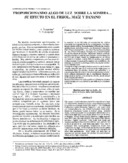| dc.contributor.author | Torquebiau, E | |
| dc.contributor.author | Akyeampong, E | |
| dc.date.accessioned | 2021-01-30T16:27:36Z | |
| dc.date.available | 2021-01-30T16:27:36Z | |
| dc.date.issued | 1994 | |
| dc.identifier.uri | https://repositorio.catie.ac.cr/handle/11554/10245 | |
| dc.description.abstract | La cantidad de reducción del rendimiento de cultivos provocada por competencia de la luz y nutrimentos, fue determinado en tres cultivos frecuentemente utilizados en sistemas agroforestales: maíz(Zea mays L, var. Katamaini Composite), frijol(Phaseolus vulgaris L., var. Rose Coco) y banano(Musa sp., var Dwarf Cavendish). Trabajos en la Estación Experimental Machacos del ICRAF, utilizando sombra artificial, demostrando que el maíz fue más afectado con una reducción del 27% que el frijol, donde los rendimientos no se vieron afectados o el banano, con un 30% de sombra, que resultó verdaderamente en un pequeño aumento de rendimiento, sin embargo, la madurez se prolongó y hubo un mayor incidencia de enfermedades. Trabajo de campo con frijol y banano asociado con Grevillea Robusta, demostró que hasta la mitad de las reducciones en rendimiento bajo los árboles, pueden ser atribuidos a la competencia abajo de la tierra y no a la competencia por la luz. Otros trabajos demostraron que la distribución espacial y temporal de la luz bajo el dosel de los árboles, puede afectar el desempeño del cultivo. Es necesario seleccionar ambos cultivos y árboles en sistemas agroforestales para características que reducen la competencia de luz. | es_ES |
| dc.description.abstract | The amount of crop yield reduction caused by light and nutrient competition was determined in three crops frequently used in agroforestry systems: maize (Zea mays L., var. Katamaini Composite), beans (Phaseolus vulgaris L., var. Rose Coco) and banana (Musa sp., var Dwarf Cavendish). Work at the Machacos Experimental Station of ICRAF, using artificial shade, showed that maize was more affected with a 27% reduction than beans, where yields were not affected or banana, with 30% shade, which actually resulted in a small yield increase, however, maturity was prolonged and there was a higher incidence of diseases. Field work with beans and bananas associated with Grevillea Robusta showed that up to half of the yield reductions under the trees can be attributed to below-ground competition rather than competition for light. Other work showed that the spatial and temporal distribution of light under the tree canopy can affect crop performance. It is necessary to select both crops and trees in agroforestry systems for traits that reduce light competition. | en |
| dc.language.iso | es | es_ES |
| dc.publisher | Centro Agronómico Tropical de Investigación y Enseñanza (CATIE) | es_ES |
| dc.relation.ispartof | Agroforestería en las Américas, número 04 (1994) | |
| dc.relation.ispartofseries | Agroforesteria en las Americas;4 | |
| dc.rights | info:eu-repo/semantics/openAccess | es_ES |
| dc.subject | ZEA MAYS | es_ES |
| dc.subject | PHASEOLUS VULGARIS | es_ES |
| dc.subject | MUSA | es_ES |
| dc.subject | AGROFORESTERIA | es_ES |
| dc.subject | SOMBRA | es_ES |
| dc.subject | RADIACION SOLAR | es_ES |
| dc.subject | AGROFORESTRY | es_ES |
| dc.title | Proporcionando algo de luz sobre la sombra...su efecto en el frijol, maíz y banano | es_ES |
| dc.title.alternative | Shedding some light on shade...its effect on beans, maize and bananas. | es_ES |
| dc.type | Artículo | es_ES |
| dc.journal.issueNumber | 4 | |


